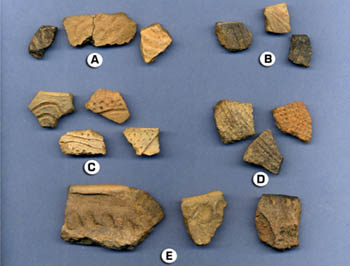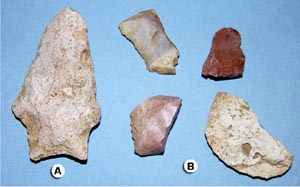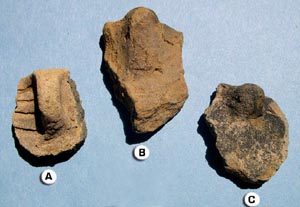
Pottery types found at the Mitchell Point site include: (A) Lamar Complicated Stamped, (B) Marsh Island Incised, (C) Fort Walton Incised, (D) Wakulla Check Stamped, and (E) Carrabelle Punctated.
Mitchell Point Site
by Frank D. Howard
and Susan Sapronetti
Spring 1990
In our continuing efforts to record even the small bits of information concerning the past inhabitants of North Florida, we list this site for future reference. Unfortunately, it is now part of a developed subdivision.
The site is located on Mitchell Point, a small stem of land that protrudes into Lake Iamonia in northern Leon County. It is a cleared lot of land, approximately one acre in size, which overlooks the lake. The west side of the lot drops off some twenty to thirty feet into a small stream bed. In 1990, only a single lot was cleared in preparation for building. Soil disturbance extends down only a few inches on the north side of the lot. The center of the lot is occupied by a very fine home in the final stages of completion.
The adjacent lot appears very level but was not cleared at the time.
 (A) Hamilton Projectile Point and (B) Chert with secondary work. |
After obtaining permission from the land owner, we surface collected for artifacts. The few collection forays yielded a good number of pottery shards, chert chips and a single intact Hamilton projectile point. This small sample enabled us to tentatively determine a time frame for this site. The types of pottery listed below are a sample of what was found:
- Wakulla Check Stamp - this is a type that has sand tempering in the clay. It is stamped with a design made up of many small checks. These checks are not more than 5mm across. We also found the Leon Check Stamp, which is a very similar stamp, but the checks are larger than 5mm across.
- Lamar Complicated Stamped - this style is typified by numerous complex and curved lines. These designs were made by stamping the pottery with a wooden paddle which was carved on one side with the design in relief. This pottery differs from earlier complicated stamps, in that the stamping is sloppily applied over itself. Also the pottery is coarsely tempered with sand and grog.
- Fort Walton Incised - is a type that is incised with lines and punctated areas. These designs are made in a wide variety of swills, scrolls and circular lines. The background areas are filled with punctations in a large band around the pot. These pieces were not large enough to clearly identify all the variations.
- Carrabelle Punctated/Meginnis Variant - In this style the potter used her/his fingertips to impress punctations into the outside of the bowl. These punctations generally form a band around the lip of the bowl. This type has a sand tempering in the clay.
- Marsh Island Incised - in this style patterns are created by more than one parallel line drawn to form chevrons, checks or diamonds, in a band around the pot. The type also has a sand tempering in the clay.
 Types of knobs found at the Mitchell Point site include: (A) Pinched Plan Lug, (B) Plan Lug, and (C) Simple Node. |
A few pieces of pottery were found with knobs. These knob types ranged from a simple node to a saddle lug. One fragment of a handle was also found, but it was not big enough to positively identify the type. Some pieces of burned clay were found, the largest piece measuring about 5cm squared, and flat on one side. This indicates that it was possibly baked on wood, but there are no clear impressions of a wood grain.
Pottery shards with fluted rims were also found. Fluted rims have a series of vertical finger impressions around the lip of the pot. These flutes are generally made within a finger's breadth of each other (only a few millimeters between each). We also found some plain rims, as well as some which were punctated.
Many plain pieces of pottery without designs were found. These plain shards were found in a variety of slip colors. These pieces vary in the makeup of their tempering from very fine sand to large grog. The majority of pieces were 5cm across or less. There was a varied difference in the thickness ranging from 3mm to 2cm.
Among the pottery many fragments of chert were found. These small chips were 5cm or less in sizes. A few pieces did have secondary work, but they were only fragments of a tool or a projectile point. A few larger fragments of chert were also found. These fragments had ruff edges with no signs of secondary working. This suggests they were merely discarded instead of used.
With our sample identified we can now roughly date the period of this site. The Wakulla Check stamp design of pottery begins in the Weeden Island Period around 750 AD during the Woodland Culture (500 BC to 1000 AD). The Weeden Island style of pottery we found at this site could date to around that time. Other pottery types we found belong within the Fort Walton Culture, which began around 1000 AD and ended around the time of the Spanish explorers.
Flat topped earthen temple mounds were built during the Fort Walton Culture. The nearest such mound to the Mitchell Point site is the Lake Jackson Mound Complex, approximately 15 miles south. Also during this phase, Chiefdoms were formed, central plazas were established, and villages began to grow to accommodate a growing population. These people lived in homes with circular floor plans and palm thatched domed roofs. Hunting, fishing and gathering were still a very important part of their lives. Although the farming of cultivated vegetables, such as corn, squashes and beans were the main staple, a number of wild plants were also a part of their diet. They used a network of foot trails between their villages to trade goods, such as pottery, animal skins, salt, soapstone, copper and mica.
It wasn't just the Indians who found this site a favorable area to live. A few pieces of glass and porcelain were also found, indicating that early settlers had also inhabited this site.
This was only a single 'lot' of land and may not seem significant. But it does show us that people did reside here long ago. As a small piece to a larger picture, it begs the question of how many people were here at one time or another. With so much development having occurred we can only guess at the size of this possible village and/or its population.
In this north Florida region there has been much archaeological research, including excavations, into known Native American population centers. These sites include San Luis Spanish Mission, the Lake Jackson Indian Mound group, Lechtworth Indian Mound group, known settled areas around Lake Miccosukee, DeSoto's winter camp, and many others. All of these point to the fact that the Tallahassee area was densely populated with a thriving Native American Indian population.
This little site on Mitchell Point is another reminder of just how far their territory extended. The state of urban development has certainly precluded any further archaeological research into this site. But that does not prevent us from wondering just how big this 'village' was, or who lived here, or how they lived. This is the line of inquiry that drives us to spend time surface collecting in remote locations such as this.
